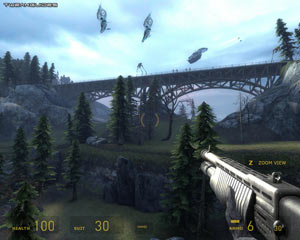Half Life 2 & Source Engine Tweak Guide
[Page 3] Troubleshooting Tips
This section contains specific troubleshooting tips which address many of the common problems experienced by Half Life 2 and Source Engine game players. I can't stress enough the importance of taking the time to go through the checklist of advice below if you're having a problem with the game.
Official Support: If you have a problem with the game, the first place to check is the Steam Support Site, which now provides all official support for all Valve games. If you still can't find a solution, you can seek interactive community tech support on the Steam Forums.
System Requirements: The minimum system requirements for Half Life 2 and Source Engine games has evolved slightly over time due to the way the game engine has been upgraded with new technologies, but in general the minimum requirements are very low. The latest requirements for HL2: Episode 2 and other recent Source games can be found at the bottom of this page.
Steam Issues: Steam is an integral part of Half Life 2 and Source Engine game functionality, so see the Steam section on Page 4 of this guide for more detailed coverage of Steam-related issues and functionality.
Graphical Issues: If you experience any strange glitches or other graphics-related issues, make sure you are using the very latest graphics drivers. In particular Nvidia users should be using the Beta Forceware 163.75 or newer, as these are specifically designed for HL2: Episode 2.
Audio Issues: If you have looping or skipping audio, see further below. If you have missing spoken dialog, change your 'Audio (Spoken) Language' setting to anther language, click Apply, then change it back for the spoken dialog audio to be correctly implemented. See the Audio section on page 5 of the guide for more details.
Stuttering: One of the most famous aspects of the Source Engine is its tendency for Stuttering, including skipping or looping audio at certain points, or periodically. The actual issue revolves around the way the engine is continually loading chunks of texture information on the fly from your hard drive into Video RAM - such as when you walk around a corner into a new area, or see a new creature - the audio pauses or skips at the same time. Let me be clear: it's not actually an audio issue, it's a general game engine issue. The early history of this issue is covered in greater detail here: Half Life 2 Stuttering. Over time Valve has released a range of updates which have minimized this issue with varying degrees of success.
Importantly: If you want to reduce stuttering then you must defragment your hard drive after installing and updating Half Life 2 or your Source Engine games. Make sure you do this after each and every time you update these games via Steam, and also whenever you install new drivers or Windows patches. Using the built-in Windows defragmenter is OK, but a third party defragmenter such as Diskeeper does a much more thorough job. One specific tip which can help reduce stuttering even further is to defragment inside the large .GCF Steam cache files. You can do this within Steam itself by right-clicking on a game, selecting Properties, and under the 'Local Files' tab click the 'Defragment Cache Files' button. Alternatively, to do an even better job, use the free GCFScape utility to defragment the .GCF files. More details on defragmentation, hard drive and virtual memory optimization are in the relevant chapters of the TweakGuides Tweaking Companion. Do not skip these steps as they have a noticeable impact on reducing stuttering in Source games.
Background Programs: Disable all unnecessary background applications - especially virus, trojan and spyware scanners and messaging utilities. These applications can and do use up valuable CPU resources, take up precious RAM, cause memory conflicts and crashes to desktop, but most importantly they interfere with read/writes to your hard drive effectively slowing it down and causing even more in-game stuttering and longer loading times. Full instructions on how to identify your startup programs and services and how to correctly disable unnecessary ones are in my TweakGuides Tweaking Companion. This is an important step you should not miss.
Overclocking: The Source Engine is generally not as sensitive to overclocking, but if you've overclocked any components on your system and are having problems such as crashes, reboots and graphical anomalies, the first thing to do is set everything back to default speeds and try running the game. If you don't experience the same problems at default speed, or they're reduced in severity, then your overclock is the primary culprit. Either permanently reduce your overclock and/or increase cooling to regain stability. Don't assume that because other games run with stability at a particular speed, or that previous versions of Half Life 2 ran without issue, that the latest build of the Source Engine will do the same.
That's just a basic rundown of troubleshooting tips. Read the remainder of this guide for more specific settings and tweaks which can help improve your performance and resolve any problems.

